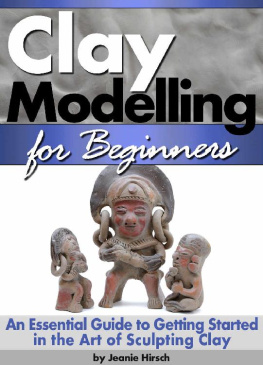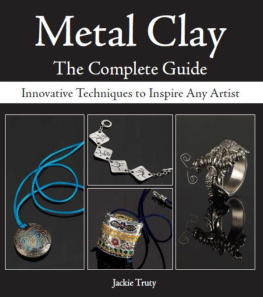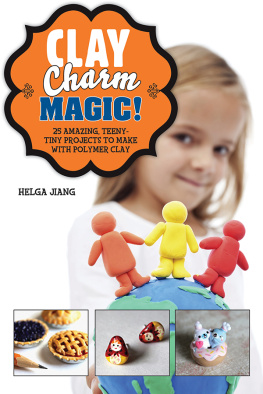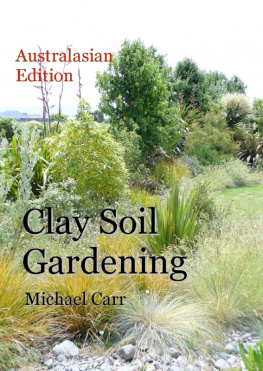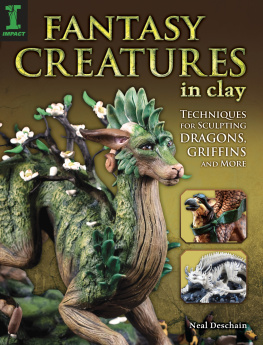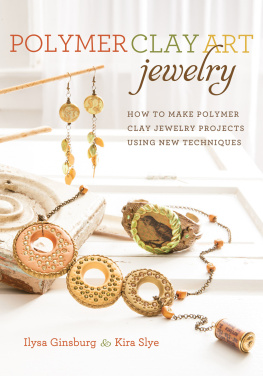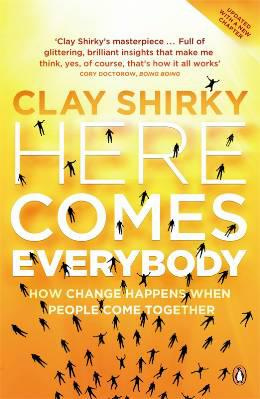Jeanie Hirsch - Clay Modelling for Beginners: An Essential Guide to Getting Started in the Art of Sculpting Clay ~ (Clay Modelling | Clay Modeling | Clay Art)
Here you can read online Jeanie Hirsch - Clay Modelling for Beginners: An Essential Guide to Getting Started in the Art of Sculpting Clay ~ (Clay Modelling | Clay Modeling | Clay Art) full text of the book (entire story) in english for free. Download pdf and epub, get meaning, cover and reviews about this ebook. year: 2015, publisher: UNKNOWN, genre: Children. Description of the work, (preface) as well as reviews are available. Best literature library LitArk.com created for fans of good reading and offers a wide selection of genres:
Romance novel
Science fiction
Adventure
Detective
Science
History
Home and family
Prose
Art
Politics
Computer
Non-fiction
Religion
Business
Children
Humor
Choose a favorite category and find really read worthwhile books. Enjoy immersion in the world of imagination, feel the emotions of the characters or learn something new for yourself, make an fascinating discovery.
- Book:Clay Modelling for Beginners: An Essential Guide to Getting Started in the Art of Sculpting Clay ~ (Clay Modelling
- Author:
- Publisher:UNKNOWN
- Genre:
- Year:2015
- Rating:3 / 5
- Favourites:Add to favourites
- Your mark:
- 60
- 1
- 2
- 3
- 4
- 5
Clay Modelling for Beginners: An Essential Guide to Getting Started in the Art of Sculpting Clay ~ (Clay Modelling: summary, description and annotation
We offer to read an annotation, description, summary or preface (depends on what the author of the book "Clay Modelling for Beginners: An Essential Guide to Getting Started in the Art of Sculpting Clay ~ (Clay Modelling" wrote himself). If you haven't found the necessary information about the book — write in the comments, we will try to find it.
Jeanie Hirsch: author's other books
Who wrote Clay Modelling for Beginners: An Essential Guide to Getting Started in the Art of Sculpting Clay ~ (Clay Modelling? Find out the surname, the name of the author of the book and a list of all author's works by series.
Clay Modelling for Beginners: An Essential Guide to Getting Started in the Art of Sculpting Clay ~ (Clay Modelling — read online for free the complete book (whole text) full work
Below is the text of the book, divided by pages. System saving the place of the last page read, allows you to conveniently read the book "Clay Modelling for Beginners: An Essential Guide to Getting Started in the Art of Sculpting Clay ~ (Clay Modelling" online for free, without having to search again every time where you left off. Put a bookmark, and you can go to the page where you finished reading at any time.
Font size:
Interval:
Bookmark:
Clay Modelling for Beginners
An Essential Guide to Getting Started in the Art of Sculpting Clay
Wait! Before You Continue
Were Giving Away Something BIG..
Im talking about a VERY BIG PRIZE .
That You Can EASILY WIN..
And it only Takes 30 Seconds..
.. CLICK HERE TO FIND OUT MORE ..

www.bluebirdbookclub.com
Dont Miss Out on This EXCLUSIVE, LIMITED-TIME GIVEAWAY !
.. CLICK HERE FOR MORE INFO ..
Table of Contents
Introduction
Sculpting and modelling with clay is a fun way to spend your spare time. Everyone can enjoy this activity, regardless of age. And the best part is that it doesnt cost much to get started. With a little creativity (and guidance from this book) you can find everything you need already in your home. Yes, there are specialized tools, too, that can make sculpting and modelling with clay easier. However, they are not necessary initially.
This book is designed to help you get started working with clay in a simple, affordable, and fun way by first making small shapes and figures to get familiar with the material and gain practice. Because working with clay is such a relaxing and therapeutic hobby, most people who try it end up completely addicted. Once you come to love the medium, youll find advice on what additional tools youll need to invest in to complete projects that are slightly more challenging.
You will also enjoy experimenting with clay extruders, armatures, and larger models. Dont worry if these terms are unfamiliar to you now. This book will cover all the basic terminology, concepts, and materials used, including the various types of clay to choose from. Lets get started!
Copyright 2015 by Miafn LLC - All rights reserved.
This document is geared towards providing reliable information in regards to the topic and issue covered. The publication is sold with the idea that the publisher is not required to render accounting, officially permitted, or otherwise, qualified services. If advice is necessary, legal or professional, a practiced individual in the profession should be ordered.
- From a Declaration of Principles which was accepted and approved equally by a Committee of the American Bar Association and a Committee of Publishers and Associations.
In no way is it legal to reproduce, duplicate, or transmit any part of this document in either electronic means or in printed format. Recording of this publication is strictly prohibited and any storage of this document is not allowed unless with written permission from the publisher. All rights reserved.
The information provided herein is stated to be truthful and consistent, in that any liability, in terms of inattention or otherwise, by any usage or abuse of any policies, processes, or directions contained within is solely and completely the responsibility of the recipient reader. Under no circumstances will any legal responsibility or blame be held against the publisher for any reparation, damages, or monetary loss due to the information herein, either directly or indirectly.
Respective authors own all copyrights not held by the publisher.
The information herein is offered for informational purposes solely, and is universal as so. The presentation of the information is without contract or any type of guarantee assurance.
The trademarks that are used are without any consent, and the publication of the trademark is without permission or backing by the trademark owner. All trademarks and brands within this book are for clarifying purposes only and are the owned by the owners themselves, not affiliated with this document.
Chapter 1: The Different Types of Clay
There are two main categories of clay, oil-based and water-based. Then there are hybrids and non-clay sculpting materials to consider.
Oil-Based Clays : Oil-based clay is referred to as plasticine. This clay contains oil, sometimes mixed with wax or sulphur. It does not dry out like a water-based clay. Animation artists prefer this clay since the finished pieces can be moved and positions adjusted. Plasticine works well for long-term projects.
Plasticine is good for modelling applications only if it does not contain sulphur. A modelling application means the sculpture will be used to make a mold of the piece. Then multiples will be cast with clay slip, resin, or other materials. The clay piece will then be recycled for another modelling application. If the plasticine contains sulphur, the molding process will not work. So if you intend to make molds of your sculpture, be sure to get plasticine without sulphur.
Plasticine can be purchased from any craft store. It can be found in the children's craft section of major box stores. The best deals for plasticine are usually found on-line at discount stores. A 1 lb. block of plasticine retails for under ten dollars.
Water-Based Clays: These clays are known as ceramic and slip clays. They are clay mixed with minerals and water. They are used for large-scale modelling, creation of ceramics such a dinner ware, and slip casting. Slip casting is a process of pouring liquid clay into a mold to produce a hollow form. That form will dry within the mold. Once it is dry, or set, it will be fired at high temperatures in a kiln and then glazed.
These clays tend to dry rapidly and have to be protected from the air. While working with the clay an artist will continuously mist the piece with water. Once the piece is finished and ready to be dried, it will still be wrapped with a damp towel or paper towels to prevent rapid drying. If the piece dries too rapidly, cracks and breaks can occur.
Although this clay can be reused, it is a messy process if the clay dries out completely. The hardened clay will have to be soaked in a bucket of water and broken down gradually. If the clay has been fired in a kiln, it is not possible to recycle it.
Water-based clay can be purchased from art stores and on-line art stores. A 25 lb. box of clay retails for under 20 dollars. Again, look for great deals from on-line and discount art supply stores.
Paper Clay: Paper Clay is water-based clay with fiber added. Typically paper is the fiber of choice hence the name. This clay is used just like normal water-based clays. The main difference is that unfired pieces are stronger than traditional unfired pieces. It is a good medium for creating dolls.
Paper clay is gaining popularity because it does not require the same attention to detail and joining of pieces. If a crack in the structure occurs, it is easily fixed with a slip made of more paper clay. Details are quickly added onto dry pieces as well. These differences make it a better medium for new artists that wish to make the leap from oil-based to water-based clays.
Paper clay can be purchased from art stores and on-line stores. It can also be made by mixing fibers into water-based clay you may have on hand. Paper clay's retail price varies by application purpose. A 5 lb. bucket of Crayola Air Dry Clay retails for under ten dollars. In contrast, a 5 lb. bag of Activa CelluClay retails at just under 30 dollars.
Polymer Clay: This is not really clay at all. It is a type of plastic made of polymer polyvinyl chloride (PVC) and a liquidizer. This sculpting medium is very firm and requires extensive kneading to become pliable. Once pliable, it is a very easy medium to use. The finished piece can be fired in a kitchen oven at low temperatures. Since a commercial kiln is not needed, polymer clays become more affordable to work with on small-scale projects.
Polymer clay has gained popularity for crafts and figurines. It is also popular for making beads for jewelry applications. It comes in a variety of colors and finishes which reduces the need for painting. It can even be purchased in metallic and pearls.
Font size:
Interval:
Bookmark:
Similar books «Clay Modelling for Beginners: An Essential Guide to Getting Started in the Art of Sculpting Clay ~ (Clay Modelling»
Look at similar books to Clay Modelling for Beginners: An Essential Guide to Getting Started in the Art of Sculpting Clay ~ (Clay Modelling. We have selected literature similar in name and meaning in the hope of providing readers with more options to find new, interesting, not yet read works.
Discussion, reviews of the book Clay Modelling for Beginners: An Essential Guide to Getting Started in the Art of Sculpting Clay ~ (Clay Modelling and just readers' own opinions. Leave your comments, write what you think about the work, its meaning or the main characters. Specify what exactly you liked and what you didn't like, and why you think so.

